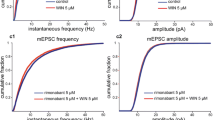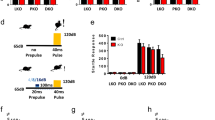Abstract.
Cannabinoid CB1 receptors occur as presynaptic receptors producing inhibition of neurotransmitter release. To elucidate their physiological role, experiments on tissues from CB1 receptor knockout mice would be helpful. We studied whether CB1 receptor-mediated inhibition of acetylcholine release is detectable in the brain of NMRI mice and of CD-1 and C57BL/6J mice (the latter two strains representing the wild-type strains of the two CB1 receptor knockout mouse models). Brain slices preincubated with [3H]choline were superfused and tritium overflow was evoked electrically (3 Hz) or by introduction of Ca2+ into Ca2+-free K+-rich medium (35 mM) containing tetrodotoxin.
The electrically evoked tritium overflow from NMRI mouse hippocampal slices was inhibited (maximally by 60%) by the cannabinoid receptor agonists CP-55,940 and WIN 55,212-2 but not affected by WIN 55,212-3 (the inactive enantiomer of WIN 55,212-2; pEC50=7.9, 7.4 and <5.5). The concentration-response curve of WIN 55,212-2 was shifted to the right by the CB1 receptor antagonist SR 141716 (apparent pA 2=8.6). Compared to hippocampal slices from NMRI mice, WIN 55,212-2 1 µM inhibited the electrically evoked overflow (1) from cortical slices from NMRI mice to a lesser extent and from striatal slices not at all, (2) from hippocampal slices from CD-1 and C57BL/6J mice to an identical extent and (3) from hippocampal slices from Sprague-Dawley rats to at least the same extent. SR 141716 0.32 µM abolished the effect of WIN 55,212-2 1 µM in hippocampal slices from NMRI, CD-1 and C57BL/6J mice and in cortical slices from NMRI mice. The electrically evoked tritium overflow from NMRI mouse hippocampal slices was also inhibited by the muscarinic receptor agonist oxotremorine (maximum effect of 85%; pEC50=6.5) and this effect was antagonized by the muscarinic receptor antagonist AF-DX 384 (apparent pA 2=8.3). The Ca 2+ -evoked tritium overflow from NMRI mouse hippocampal slices was inhibited by WIN 55,212-2 in a manner sensitive to SR 141716.
In conclusion, the cholinergic axon terminals of the NMRI mouse hippocampus are endowed with presynaptic CB1 receptors. Such receptors are also detectable in the hippocampus of CD-1 and C57BL/6J mice. The maximum extent of the CB1 receptor-mediated inhibition of acetylcholine release is lower than the maximum effect mediated via the autoreceptor.
Similar content being viewed by others
Author information
Authors and Affiliations
Additional information
Electronic Publication
Rights and permissions
About this article
Cite this article
Kathmann, M., Weber, B. & Schlicker, E. Cannabinoid CB1 receptor-mediated inhibition of acetylcholine release in the brain of NMRI, CD-1 and C57BL/6J mice. Naunyn-Schmied Arch Pharmacol 363, 50–56 (2001). https://doi.org/10.1007/s002100000304
Received:
Accepted:
Issue Date:
DOI: https://doi.org/10.1007/s002100000304




